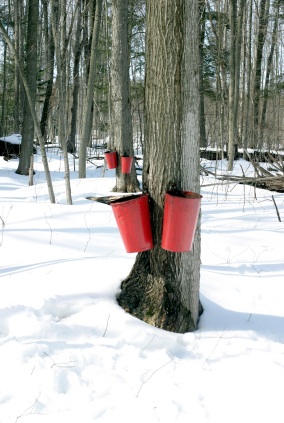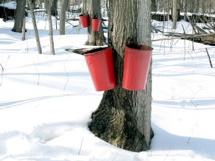
buckets, l
(article, Megan Holden)
In Little House in the Big Woods, the first of Laura Ingalls Wilder’s memoirs about her youth on the frontier, Pa tells Laura how Grandpa harvested the “blood of the tree” to make maple sugar. Little has changed since Grandpa tapped trees by hand in the early 1800s; throughout the northeastern U.S. and southeastern Canada, the “sugaring off” season still involves waiting for just the right weather and boring holes, one by one, into the trees. The result — the caramel-colored elixir poured over pancakes and waffles — tastes the same as it did to Grandpa. [%image buckets float=left caption="Sugar season means buckets on trees." credit="Photo: iStockphoto/oddrose"] Every year, I order a half-gallon jug of Grade B syrup from the Corse Farm in Vermont; my best friend introduced me to the maple treats produced by Roy Corse, and now my family’s hooked. Vermont — located within the crescent-shaped swath of the U.S. and Canada known as “Maple Syrup Nation” — produces more than a third of the nation’s maple syrup. A sure sign of spring in Vermont is the sight of steam rising from the sugar shacks that dot the state’s rolling hills. The exact date varies from year to year, but a span of crisp cool nights (the thermometer must drop below freezing) paired with warm sunny days starts the sap rising up through the sugar maples. In the Green Mountains of southern Vermont, generations of the Corse family have been making maple syrup since 1868. Each spring, Roy Corse loads his wagon with buckets, drills, and yards of plastic tubing and heads to the “sugar bush.” Sugar season means grueling work. Crews set the taps by drilling holes in the maple trees. The tap hole immediately captures the sap flowing up the tree and diverts it into a bucket. On a nice day, a big tree can produce two gallons. The steel buckets have lids to keep out the snow, twigs, and squirrels. On many farms, plastic tubing has replaced buckets with gravity pumps siphoning the sap. [[block(sidebar). h1. Sugar season Corse Farm 1089 Corse Road Whitingham, VT 07361 802-368-2420 The annual Vermont Maple Open House weekend (March 23-25) is held at sugar houses all over the state. Look them up at the Vermont Maple Sugar Makers’ Association. "A Sugar Bush Tale" is a documentary about sugaring off. Enjoy the syrup while you can: Both the New York Times and Slate have reported this spring on the effects of global warming on maple-sugar production. ]] The "gathering crew" works daily, often on snowshoes, to harvest the fresh sap in collection vats drawn through the woods on sleds. Some farms still use horse-drawn sleds, but Corse traded in his horses for the ease of the tractor. In any given year, he sets 9,000 to 11,000 taps, a large operation for southern Vermont. Once gathered, the next step is boiling the sap down into syrup. The weather is usually cold and nasty, but the sap house is a sweet-smelling steam bath. The Corse Farm fires its evaporator (the large flat pans used to boil the sap and concentrate the solids into syrup) with wood. Corse’s hodgepodge crew of family, friends, and neighbors feeds the fire continuously. They need a raging fire to produce enough heat to reduce 40 gallons of sap into just one gallon of syrup. Keeping the wood-fired evaporator at a roiling boil and keenly watching the temperature is critical. Vermont has the most stringent maple-syrup laws in the nation, requiring careful testing with a hydrometer to measure the syrup’s density. If it’s too thin, the syrup will ferment; too thick, and it will crystallize. The state strictly grades all syrup by color. The lightest in color (and, many claim, the most distinguished and delicate in flavor) is the light amber “Vermont Fancy” made from early-season sap. It’s Roy Corse’s favorite. The medium amber-colored Vermont Grade A has a more pronounced maple flavor; it’s an all-purpose syrup that tastes heavenly on pancakes and waffles. The dark amber Vermont Grade A has a more robust flavor with sweet caramel overtones, making it another excellent choice for table use or in recipes. Finally, Vermont Grade B, the darkest and thickest of the table grades, is made from the last sap of the season and is an excellent cooking and flavoring syrup. [[block(sidebar). h1.Featured recipes]] Every sugar maker loves a “sugar snow.” As Pa explains to Laura, it’s called a sugar snow because a late snow “means that men can make more sugar.” A cold spell with snow “will hold back the leafing of the trees, and that makes a longer run of sap.” In the woods, sugar season is a magical time. And the moment is distilled for the rest of the year into liquid gold. p(bio). Megan Holden writes about food and family from her home in Portland, Oregon.

buckets, l

reference-image, l